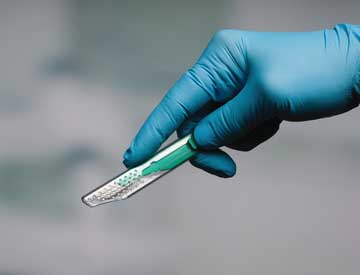If you doubt the contention that it can take years — or even decades — for evidence to trickle into clinical practice, look no further than the lack of progress in implementing simple precautions to prevent avoidable staff injuries from needles, scalpels, syringes and other sharp surgical instruments.
An estimated 385,000 hospital workers in the U.S. suffer a sharps injury each year and nearly half of the incidents take place in operating rooms, making them the leading clinical area in which the injuries occur, says Renae Wright, DNP, RN, CNOR, perioperative practice specialist with the Association of periOperative Registered Nurses (AORN). Sharps injuries are believed to take place in as many as 15% of surgeries. One 2019 review concluded that surgeons suffered a sharps injury in one of every 10 operations. Dr. Wright says 64% of the injuries are estimated to be preventable and that as many as 90% of them go unreported. “We haven’t seen a whole lot of improvement in this area,” she adds.
Deborah L. Spratt, MPA, BSN, RN, CNOR, CHL, agrees. “It’s 2022, two years after the 20th anniversary of OSHA’s Needlestick Safety and Prevention Act, and here we are, talking about the same thing,” says Ms. Spratt, a perioperative consultant based in Rochester, N.Y. “We’re still not getting it right.”
Implementing a successful sharps safety program requires a culture change in any facility embarking on it. Fortunately, Ms. Spratt is beginning to see a shift in willingness among surgical professionals to make the necessary conversions and notices more surgeons being amicable to making practice changes that benefit the safety of the entire OR team.
.svg?sfvrsn=be606e78_3)


.svg?sfvrsn=56b2f850_5)